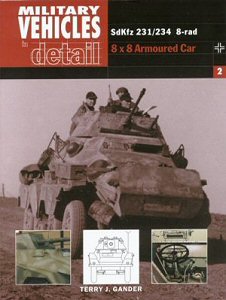

 Military
Vehicles in Detail 2
Military
Vehicles in Detail 2Review by Peter Brown
Most coverage is given to the 231 "Achtrad" which is described in several sections. Starting from the ground up, the basic chassis plus engine, gearbox and suspension is examined using descriptions and photos from the original user manual and a British technical study of a captured vehicle. Hull and turret are then shown though the armament section is not as well detailed, a superb original drawing of the 231 gun mounting is included but not the weapons which went in them though there are close-ups of the two driver’s areas. The related 232 with its large aerial array and the 233 with short 75mm are then described, but only brief details of the 263 dedicated radio vehicle are given and just one photo of it.
Although the 231 series had its merits, a revised design with air-cooled engine was developed with use in hot climates in mind. This also did away with the chassis, using a monocoque design to reduce the overall height as well as increasing ground clearance. Produced too late to be used in North Africa, this series also had several versions ranging from the original 234/1 with open topped turret and 20mm cannon, the 234/2 often called Puma with a 50mm gun and 75mm gun versions 234/3 with short gun and 234/4 with long barrel antitank gun. This later series is not described in the same detail as the 231 with no photos of the new engine, but there are two good photos of the 234/2 turret interior and the guns on preserved 234/3 and 234/4 which also get a few colour shots.
The technical sections are well written and backed up with tables showing the main characteristics of each type. Photos vary widely in quality, some are very good several of the in-action ones are grainy and their appearance is not helped by printing some as double-page spreads. This also means that detail is lost across the spine of the book, which also happens with most of the few drawings. While not much is lost on an original cross-section view, the scale plans of the 234/2 have enough missing to spoil them and these could also have been better detailed.
Another let-down is the final chapter headed Operations and Markings, this gives little on operations with just a few paragraphs on how a German armoured car unit was organised and nothing on them in use, for colours and markings the details provided are very basic though there are six pages of colour drawings of tactical and unit markings which do not offer much new and only repeat what has been in the first Military Vehicles in Detail and earlier Tanks in Detail books on German vehicles.
While there are good points to this book, much of the overall effect is lost at the layout stage and by using poor photos. Some interior views are good but there is not enough of one vehicle to enable a model to be built only using what is here. Colour illustrations of markings may be acceptable for a one-off book but as part of a series it simply repeats what has gone before.
For information on ordering this book and others, see the www.ianallansuperstore.com web site.
Page created 26 November 2003